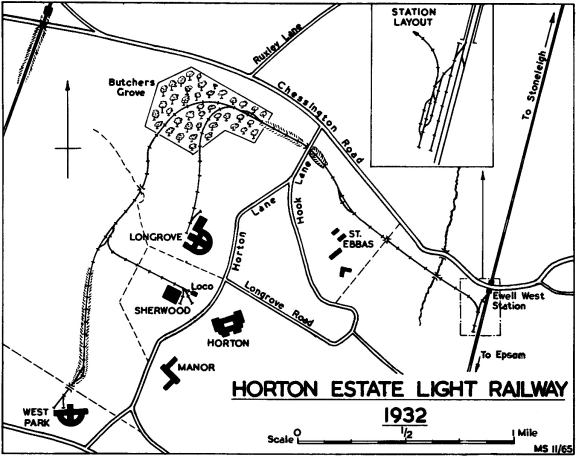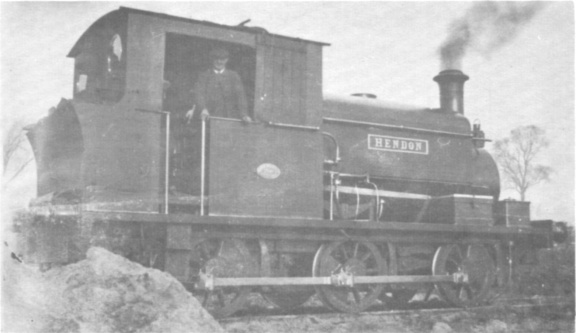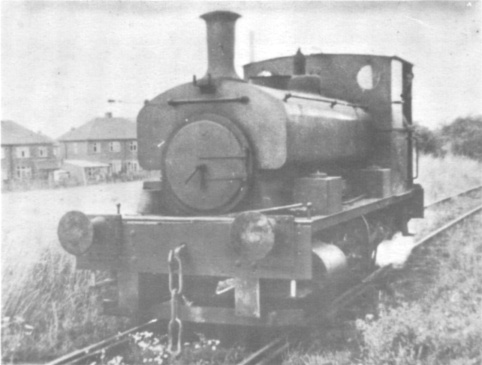
| THE INDUSTRIAL RAILWAY RECORD |
© MARCH 1967 |
HORTON ESTATE LIGHT RAILWAY
C. G. DOWN
In 1903 the London County Council decided that a new hospital, Longrove Asylum, should be built on Horton Lane at Ewell as the first hospital in the area, Manor, built in 1899, was already insufficient. On 20th August the contract for the construction of the hospital foundations was awarded to Charles Wall Ltd. They experienced great difficulty in transporting materials to the site, but by using traction engines as well as horses and carts the job was finished in November 1904. The traction engines were the cause of much annoyance to local residents, owing to their noise and vibration, and because they damaged the surface of the roads although these were little more than mud tracks.
On 15th December 1904 Forster & Dicksee, of London and Rugby, gained the contract for the construction of the superstructure of the hospital and were given until June 1907 to complete it. Due to the difficulties experienced by the previous contractors, they applied to the Board of Trade for permission to build a standard gauge light railway from the L.S.W.R. station at Ewell West up to the site, crossing the Epsom to Ewell bridle path and the Hook Road on the level. Negotiations lasted over two months but the parties concerned - the London County Council, Epson Rural District Council, Epson Urban District Council and the Iwell Parish Council - eventually agreed to the construction of the railway. Forster & Dicksee immediately got to work, using a Manning Wardle 0−6−0 saddle tank named HOLLYMOOR, and the first train-load of bricks and cement reached the site on 20th April 1905. "On the site itself, extensive use of tramlines from the Longrove end of the light railway speeded the delivery of materials to all parts of the building."
HOLLYMOOR - ‘Puffing Billy’ to the local residents - would wait at the site until a direct telephone call from the L.S.W.R. at Ewell West notified the arrival of another special goods train with materials. ‘Puffing Billy’ then set off "amid a cloud of steam and small boys" to bring the wagons back to the site. One Oliver (nicknamed ‘Red Flag’) was employed at the road crossing to give warning of these trips. A Barclay 0−4−0 saddle tank arrived new in 1904; she was named CROSSNESS and wore a livery of dark green. The use of two loco motives necessitated protection of the single line, in the form of a copper plated staff.
The construction of the hospital gave work to many hitherto unemployed. Every day nine hundred of them travelled to and from Waterloo by special train to Ewell West at a weekly fare of four shillings. However, while the bricks and cement went by train along the light railway (or ‘Forster & Dicksee’s Railway’ as it came to be known), the workers had to walk the two-and-a−half miles to the site, and passengers were never officially carried on the line.
Two accidents occurred during the building of the hospital. One involved a steam crane working ninety feet up, which was blown down on to some already completed buildings by the high winds of 2nd December 1905, causing damage amounting to some £500. In the other, ‘Puffing Billy’ ran down and killed 64−year-old Mary Tobin at the Hook Road crossing. Considering the various delays Forster & Dicksee did well to complete the contract two months ahead of schedule.

Early in 1907 HOLLYMOOR was sold (possibly direct to the Austin Motor Co. Ltd. in Birmingham), leaving CROSSNESS in sole command; the latter was fully occupied in carrying supplies for the equipping of the hospital which the L.C.C. took over in 1909. They also acquired the railway, intending to retain it for carrying coal to the boilers which heated the hospital. Accordingly, the rails were re−aligned to the east of the first site and an, under-bridge constructed at the Hook Road. The line was then entirely fenced off and a footbridge erected over the Epsom to Ewell bridle path. Soon after this the L.C.C. applied for permission to extend the railway to serve the Horton and Manor hospitals. The Board of Trade would agree to this only if the proposed lines were constructed in tunnel under the Horton Lane, and not, as was the original idea, crossing it on the level. Coupled with the difficulty of unloading coal on a sub−surface line, the extra expense was thought to be excessive, and the lines were never built.
At the, outbreak of the First World War the hospitals came under the control of a War Committee. Between 12th March 1915 and 8th April 1915 patients were evacuated from Horton Hospital which was made ready to receive wounded from the south coast ports. The idea of extending the railway to Horton was again revived, so that ambulance trains might be run direct to the hospitals, but the gradient and curvature of the projected line were thought to be too great and the scheme fell by the wayside. Wounded instead arrived at Epsom in converted L.S.W.R. vehicles and went to the hospitals by road.

HENDON, Manning Wardle 2046 of 1926. (Collection R. Crombleholme)

CROSSNESS, Andrew Barclay 994 of 1904 near Ewell West Station.
(Collection A. Neale)
In 1918 control of the hospitals reverted to the L.C.C. and a contract for the construction of another new hospital, at West Park, was awarded. To carry materials to the new site the railway was extended, both to West Park, and to Sherwood where a power station was also under construction to provide power for the whole group of hospitals. Also at Sherwood (Central Station) a permanent locomotive shed was constructed. The new West Park hospital was completed in 1921, and the railway to it ran through some very beautiful country. It had a gradient of about 1 in 40 for half-a-mile, which was adverse to trains for Ewell and limited them to a load not exceeding eight empty wagons. The traffic carried was entirely coal, but only two wagons, used for ash carrying, were owned by the L.C.C. The hard work on these trains gradually wore out CROSSNESS and a Manning Wardle 0−6−0 saddle tank, HENDON, was obtained from C. J. Wills & Sons Ltd., St. Helier, in 1935 to replace her. (HENDON had previously worked on railways laid to assist in the construction of the L.C.C. housing estates at Burnt Oak and St. Helier.) Pieces of CROSSNESS, which was cut up soon after by Fraser & Company, lay beside the locomotive shed for some time.
Many and varied were the incidents affecting the line during the Second World War. At one time, three steam locomotives were noted in the sidings at Ewell West, two in black livery, the other green. These were probably resting there en route for some other destination, but it should be noted that once or twice locomotives were borrowed from the L.S.W.R. (and later the S.R.) when the L.C.C. engine was under repair. Three bomb incidents are of note. Once, the engine crew arrived to find that the locomotive shed had collapsed and was solely supported by its inmate; bomb splinters on one occasion removed several portions of HENDON, while an unexploded bomb which had lain unnoticed by the lineside exploded a short while after the passage of a train, removing a large portion of the track and earthworks.
After the War HENDON needed a new firebox but for some reason a new locomotive, instead of a firebox, was ordered from Robert Stephenson & Hawthorns Ltd. in November 1946. SHERWOOD, an 0−4−0 saddle tank, arrived in March 1947, and worked the now infrequent trains for the remainder of the railway’s existence. HENDON, which had been sold to A. R. Adams of Newport, was found to be, in retrospect, the best locomotive of the line’s stud. SHERWOOD was totally unsuited to the long hard run. She was a poor steamer and after only a few months’ running her slide bars had become badly worn. Nevertheless, her life was not without incident for the local youth was active and she was several times derailed by stones in the points or by sleepers placed across the rails. Once, during a fog, SHERWOOD ran full-tilt into an ash-truck which someone had pushed under the Hook Road bridge; fortunately she was not derailed.
By this time the railway was getting somewhat run-down and attempts were made to have the track relaid by the Royal Engineers as an exercise, but this fell through and the L.C.C. closed the railway to traffic in January 1950. The ‘Epsom & Ewell Advertiser’ of 12th January 1950 stated that "many will regret the passing of what, for more than 40 years, was part of the life of West Ewell". The ‘Epsom Herald’ made similar comment and mentioned that "the sale price of £8,371 does not indicate that its permanent way was very permanent, nor its rolling stock luxurious".
G. Cohen, Sons & Co. Ltd. secured the whole line for breaking up, and this was completed during the year. Much of the rail went to South America, but SHERWOOD was sold to F. Watkins (Boilers) Ltd., of Coleford, later reaching the Calder & Mersey Extract Co. Ltd. in Widnes.
| Locomotive | HOLLYMOOR | CROSSNESS | HENDON | SHERWOOD |
| Builder | Manning | Barclay | Manning | Stephenson |
| Builders Number | 1519 | 994 | 2046 | 7349 |
| Year Built | 1901 | 1904 | 1935 | 1947 |
| Cylinders | 12" x 17" | 12" x 20" | 13" x 18"* | 12" x 20" |
| Wheels (diameter) | 3' 1⅜" | 3' 2" | 3' 0" | 3' 1" |
| Wheelbase | 10' 9" | 5' 6" | 11' 6" | 5' 6" |
| Heating Surface (tubes) | 326 sq ft | 400 sq ft | 491 sq ft | ? |
| Heating Surface (firebox) | 40 sq ft | 44 sq ft | 51 sq ft | ? |
| Heating Surface (total) | 366 sq ft | 444 sq ft | 542 sq ft | 402 sq ft |
| Grate Area | ? | 7¼ sq ft | 8 sq ft | 6½ sq ft |
| Pressure | ? | 140 lbs | 160 lbs | 160 lbs |
| Water Capacity | 450 galls | 560 galls | 550 galls | 500 galls |
| Coal Capacity | ? | 11 cwts | ? | 23½ cu ft |
| Weight (empty) | ? | 18 tons | ? | 16¾ tons |
| Weight (working order) | 18t 15c | 21½ tons | 24 tons | 21 tons |
| Length (over buffers) | ? | 21' 8" | ? | 20' 2¼" |
| Height | ? | 10' 10½" | ? | 10' 3¼" |
| Width | ? | 8' 0" | ? | 7' 6⅞" |
* L.C.C. records show 10½" x 18" (probably in error).
The railway began a few yards west of Ewell West railway station. Branching away from several sidings north of the L.S.W.R., the single line ran behind the Council Highways depot, crossed the river Hogsmill and began to climb past a recreation ground and the Epsom to Ewell bridle path. Then came a level stretch between the fence of St. Ebbas Hospital and the back gardens of houses along the Chessington Road before the rails began to drop and burrow under the Hook Road, a mile from the start. The line continued on a low embankment, swinging gradually westwards until it entered Butcher’s Grove, a dense marshy wood. Here, at one-and-a-half miles, was the junction for the line to West Park. One line ran more or less southwards through fields and over streams for about three-quarters-of-a-mile to Longrove Hospital. The West Park extension ran south-west, switchback-like, to the Sherwood loop and junction for the half-mile branch to Central Station, the most level stretch of track on the railway. It continued on a low embankment lined with trees and hedges for about three-quarters-of-a-mile, passed under a footbridge and entered the gates of West Park Hospital. The track itself was flat-bottom rail, on both wooden and concrete sleepers.
Numerous remains of the line can still be seen. The gate across the B.R. connection is still there as is the bridge over the river Hogsmill. The Council yard has been extended across the trackbed, and the footbridge over the bridle path has been demolished. South of the Hook Road the cutting has been filled in, but it is still clearly defined as the spoil used as a filler favours the growth of thistles! Thereafter, the trackbed is fairly clear, especially in Butcher‘s Grove where the sleeper marks are quite visible. The power station at Sherwood has been demolished and replaced by a larger and more modern installation. Otherwise, everything is much as it was. But one cannot help thinking that if the Royal Engineers had played their part the line might possibly still be in use today.
For assistance with this article I am greatly indebted to Mr S.T. Smith, Superintendent Engineer at Manor Hospital.